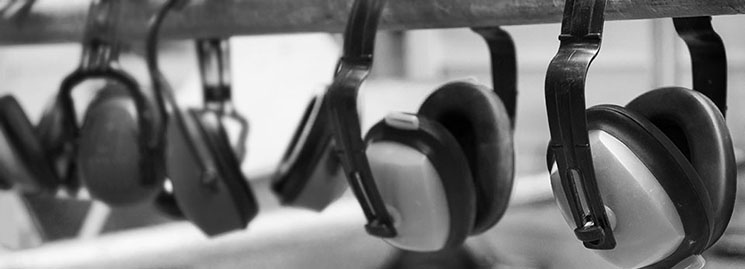Learn more about what loud noises do to our hearing
You are around damaging, loud noises more often than you think! One of the questions that I always ask my patients is “Have you ever been exposed to loud noise?” The responses I often get are “No, never”, “I don’t think so”, and occasionally I even get the response of “Yes, but not enough to cause hearing loss”. As I explore deeper into their history of noise exposure and ask if they have ever been around fireworks on the Fourth of July, ridden the L train in downtown Chicago when it goes underground, shot a gun before or been near someone while they shoot, listened to loud music on headphones, or gone to a concert, I typically discover that almost everyone has experienced most of the above.
Many times they report that those things happened so many years prior to experiencing difficulty with their hearing that they couldn’t be connected. The bad news is that all those things, in association with aging, are the reason they have hearing loss today. Sometimes it helps to give my patients an analogy that makes it easier to understand. Most of us have injured an ankle, twisted a knee, or broken a wrist. When these injuries occur in our youth our bodies are a lot like Wolverine from the X-Men and it seems as if they repair themselves overnight. We quickly forget that the injury ever happened. Then as we get older and reach the age of 60-65 our bodies start to wear down and fatigue. The same body that used to magically repair any injury overnight now gets stiff after a brisk walk and sore if you bend over to tie your shoes the wrong way. When this time of decline begins to occur the old injury that was quickly forgotten in our youth begins to sneak back up on us.
Whenever the body begins to give out, it commences to give out where the repair happened so long ago. Most of us have used or heard the phrase “The old knee injury is acting up”. This simple sentence captures perfectly the concept I am trying to explain. The same situation that occurs with the old knee injury happens with our hearing system. Those loud noise events that we encountered in our youth begin to catch up with us, and as we age and begin to wear out, our hearing system begins to wear out in the frequency pitches where it was damaged so long ago.
What loud noise does to our hearing
When we encounter loud noises, even if they are for a very brief time, they can have a permanent damaging effect on our hearing system. When a loud noise occurs it is actually a sound wave that is generated by a powerful sound source and sent through the air molecules until it reaches our ear. The sound wave travels to our eardrum through the outer ear canal and pushes it with a lot of force which causes it to retract; forcing the middle ear bones (ossicles) to also move with great mechanical force. This motion pushes all the pressure into the inner ear, which is filled with fluid. This causes something of a tidal wave in that inner ear fluid, which forces the inner ears parts and organs to move violently, which then shears off the sensitive inner hair cells. This shearing of the hair cells results in permanent damage; they cannot grow back. Even if a complete shearing of the hair cell does not occur, the trauma will eventually cause a weak spot, and, as was discussed earlier, this will inevitably result in permanent hearing loss.
The inner ear is organized “tonotopically” which means it’s organized like a piano—with certain sections dedicated to low-pitched tones and others dedicated to mid- or high-pitched tones. These are known as the frequencies. When a loud noise event occurs and the hair cells are damaged they are typically damaged in the higher frequency range, or the high-pitched tones. When the hearing system is tested, we can determine from the results with consistent accuracy if the damage was caused by loud noise damage. When this is the case it is diagnosed as a progressive high frequency hearing loss. How loud is too loud? Once we understand that sounds we didn’t think are loud enough to do damage are in fact doing damage to our sensitive hearing system, it is important to have a guideline to follow for hearing protection.
One of the most common sources of loud noise damage today is music listened to through headphones. It is very difficult to gauge how loud the music we listen to is when it comes through a headphone. The other dangers related to headphones are how close to our ear the sound is coming out, and the duration of time we spend listening to music. Listening to an IPod is something that a lot people do on a daily basis, and listening to it with the volume turned way up is also almost as common of a practice. If you have ever been able to hear the music from the headphones of someone else while at the gym or in the store, they are listening to it loud enough to do permanent damage to their hearing. A good rule of thumb while listening to headphones is that no one should be able to hear your music beyond 12 inches away from you. Apple Inc., in correlation with the OSHA standards, has set governors on their devices (IPod, IPad, etc.) so that they will not exceed an 80 dBA output, but these restrictions are easily removed through the Apple software once you get it home and load your music onto it from your computer.
Am I doomed to have hearing loss?
Most people know that as we age our hearing ability wears out and results in hearing loss. So the questions need be asked—is it a result of just getting older? Or is it associated with a lifetime of loud noises we encounter every day and have become desensitized to? Studies of indigenous populations and their hearing abilities have been performed. These studies suggest that just because we get older doesn’t mean we have to lose our hearing.
Specifically, the studies indicate that those who live secluded in the deep forests of their forefathers, who have never been exposed to our industrialized nations, don’t typically lose their hearing as they age past the years of 60-65. When they tested the hearing of individuals from these populations that were over the age of 65 they did not find that they had any progressive high frequency hearing loss, indicating that it is not just getting older that causes hearing loss, but that it is a combination of getting older and being exposed to loud noises at any point in our lives. This study gives us the promising implication that if we protect our hearing from any source of loud noise no matter how brief the duration, we do not have to expect that we will inevitably lose our hearing. If we protect our hearing by using earplugs and earmuffs there is no reason why we have to deal with the loss of our hearing in our future.
What can I do if I have hearing loss?
Since most of us have been exposed to loud noises and all of us will continue to get older, many of us may encounter hearing loss in our lifetime. The most difficult part of my job is delivering the bad news of hearing loss to my patients, but along with that I also get to inform my patients that they don’t have to live with the hearing loss. Today, hearing aids and the use of amplification can restore the majority of hearing abilities back to an individual. Hearing aids and their technology have advanced in leaps and bounds and have capabilities that were never imagined 20 years ago. When we picture the hearing aids our parents and grandparents wore we get a sick pit in our stomachs thinking we will have to wear the same type of hearing aid they had. Fortunately hearing aids today are scientifically advanced to restore hearing functionality to a normal level for most individuals, and at the same time they are smaller and more cosmetically appealing than ever.
Learn how TruHearing can help with hearing health.

